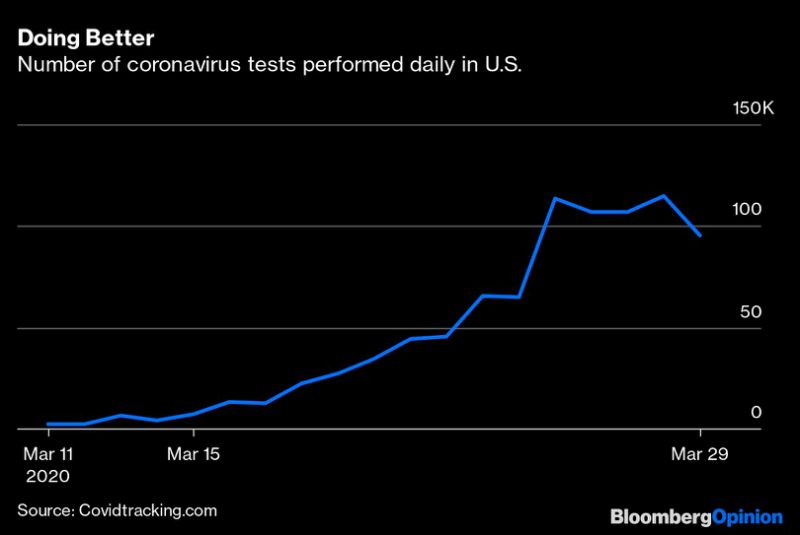
(Bloomberg Opinion) — The U.S. is finally starting to take a sensible and proactive approach toward the Covid-19 pandemic. After a disastrous initial failure, coronavirus testing has now risen to levels similar to or higher than South Korea. Meanwhile, although he almost succumbed to the temptation to reopen the economy before shutdowns had time to quell the epidemic, President Donald Trump has wisely decided to recommend that social distancing continue through the end of April. And Congress, showing rare unanimity and boldness, passed a huge relief package that will sustain most households and many businesses throughout the next couple of months.
But these are all simply holding actions, temporary measures to stop the virus from spreading out of control. Even the harshest lockdown will never eliminate the virus, and if restrictions are lifted without a regime in place to suppress new outbreaks, the epidemic will simply come roaring back. Meanwhile, every day the economy remains shutdown generates more losses and creates a larger backlog of un-serviced debt. That won’t work forever; an escape plan is urgently needed.
A team of experts at the American Enterprise Institute has come up with exactly such a plan, and it looks like a good one. Those experts include Scott Gottlieb and Mark McClellan, both former commissioners of the Food and Drug Administration; Lauren Silvis, who previously held several high positions at the FDA; and Johns Hopkins Center for Health Security professors Caitlin Rivers and Crystal Watson.
The first and most essential part of the AEI plan is to create a system that can suppress coronavirus outbreaks without lockdowns. This will require extensive testing; the plan’s authors estimate about 750,000 tests per week. Fortunately, that sort of number is now possible:
Meanwhile, new rapid tests like the one from Abbott Laboratories will reduce turnaround times so that that cases can be identified in minutes instead of days. People who test positive can immediately isolate themselves.
But testing and isolating isn’t enough to halt the virus because Covid-19 becomes contagious before many infected people start showing symptoms. To really halt the spread, therefore, public health authorities will need to use an approach called contact tracing. This means finding out who an infected person has had contact with in the past few days and notifying those people that they need to get tested even if they don’t show symptoms.
Traditionally, as in the fight against HIV/AIDS, contact tracing was done by hand. Coronavirus moves so quickly, however, that technological solutions may be needed to speed things up. Singapore, for example, has recently made its own contact-tracing app publicly available. This app relies on Bluetooth signals to tell who has been in close physical proximity to whom.
Of course, that raises privacy concerns. That has tech leaders working on alternate solutions that do contact tracing while preserving anonymity. It’s possible that Apple and Google already have the data to do this. Meanwhile, any contact-tracing app will also have to quickly notify people that they’ve been in contact with an infected person, and (ideally) route them to the nearest testing center. Those who test positive can immediately quarantine themselves at home to prevent spreading the disease.
Establishing robust test-and-trace systems can start at the local and state level. However, implementing these systems will take both money and wise policy changes. The federal government should provide generous funding to help local and state governments implement test-and-trace systems. Local governments and public-health authorities, meanwhile, must loosen their testing criteria to allow for people to be tested before they show symptoms. The AEI authors also call for a national surveillance system to tie local systems together and enable contact tracing throughout the country, as well as to help infected people quarantine themselves quickly and safely.
In addition to the test-and-trace approach, governments can use antibody tests to identify individuals who have already had the virus, and thus may be able to return to work safely. Germany is already experimenting with this approach.
After test-and-trace systems are in place, and new cases have fallen for 14 days or more in a row, the AEI team suggest lifting shutdowns — but not all at once. They recommend a phased reopening of businesses, with telework, distance learning and personal social distancing continuing as much as possible, while maintaining indefinite bans on gatherings of more than 50 people. Only once a vaccine against COVID-19 is developed — probably in mid-2021 — can all restrictions be lifted. And if outbreaks do spiral out of control in a city or state, the AEI team recommends a swift but temporary return to shutdown.
The battle against coronavirus will thus be a long one. But in a few weeks the tide may turn. The AEI plan provides a great road map for coming out of hiding and going on the offensive.
This column does not necessarily reflect the opinion of Bloomberg LP and its owners.
Noah Smith is a Bloomberg Opinion columnist. He was an assistant professor of finance at Stony Brook University, and he blogs at Noahpinion.
<p class="canvas-atom canvas-text Mb(1.0em) Mb(0)–sm Mt(0.8em)–sm" type="text" content="For more articles like this, please visit us at bloomberg.com/opinion” data-reactid=”37″>For more articles like this, please visit us at bloomberg.com/opinion
<p class="canvas-atom canvas-text Mb(1.0em) Mb(0)–sm Mt(0.8em)–sm" type="text" content="Subscribe now to stay ahead with the most trusted business news source.” data-reactid=”38″>Subscribe now to stay ahead with the most trusted business news source.
©2020 Bloomberg L.P.









